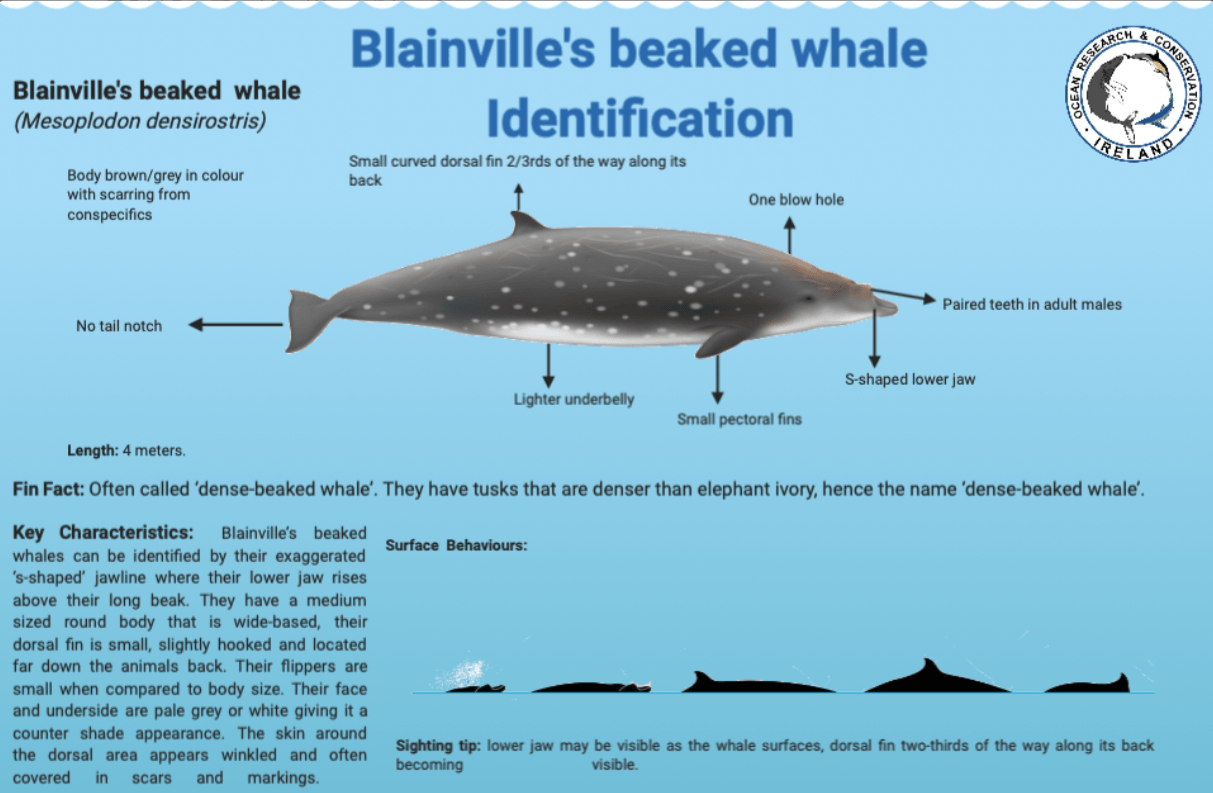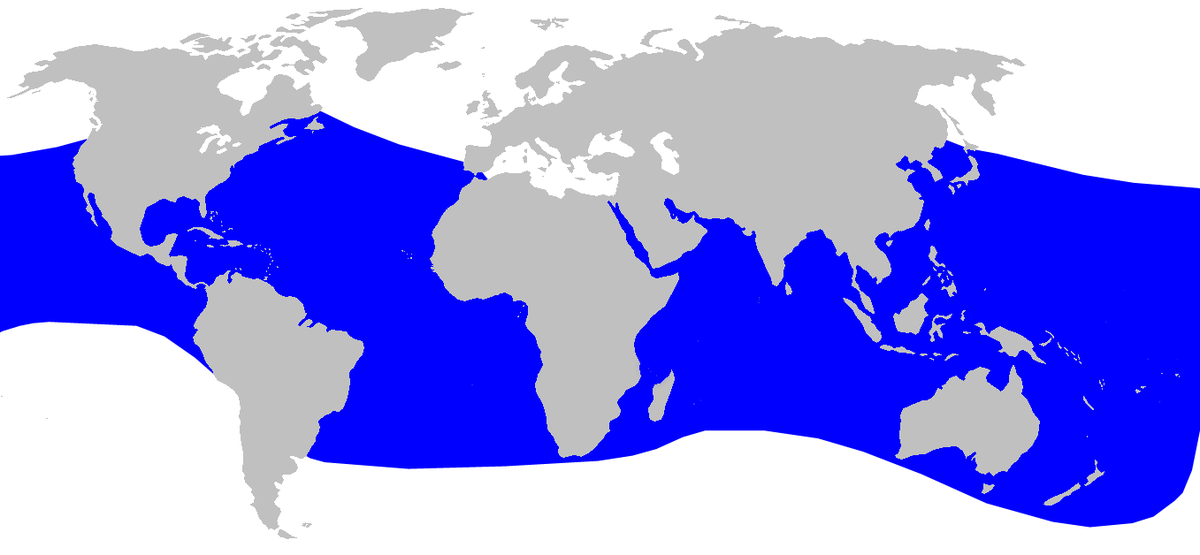Blainville's beaked whale
(Mesoplodon densirostris)
Classification:
Kingdom: Animalia
Phylum: Chordata
Class: Mammalia
Order: Artiodactyla
Infraorder: Cetacea
Family: Ziphiidae
Genus: Mesoplodon
Species: M. densirostris
Get the facts:
Blainville’s beaked whales are not well known members of the beaked whale family, Ziphiidae. Often called ‘dense-beaked whale’. They have tusks that are denser than elephant ivory, hence the name ‘dense-beaked whale’. They produce whistles to communicate and echolocation to forage, similar to which are used by other odontocetes. They are suction feeders that are found in tropical and temperate oceans.
Species Identification:
Blainville’s beaked whales can be identified by their exaggerated ‘s-shaped’ jawline where their lower jaw rises above their long beak. Mature males are easily distinguished from females and juveniles due to their large pair of teeth that erupt and tilt forward from their lower jaw. Females also have these teeth, but they remain hidden in the gum tissue of the mouth. They have a medium sized round body that is wide-based, their dorsal fin is small, slightly hooked and located far down the animals back. Their flippers are small when compared to body size. Blainville's beaked whale colouration varies from dark grey to brownish and bluish. Their face and underside are pale grey or white giving it a counter shade appearance. The skin around the dorsal area appears winkled and often covered in scars and markings. Adults can reach 15-20 feet in length and weigh 1800-2300 pounds.
Diet:
The consume their prey by suction feeding in the deep water. They have a V-shaped pair of ventral throat grooves that aids suction feeding. They primarily eat small fish and cephalopods (squid). They locate their prey using echolocation and captures it using suction.
Habitat:
They are found in tropical to temperate waters worldwide. Mostly in deep offshore waters, 656-3281 feet off the continental shelf and often associated with steep underground geological structures such as continental slopes, banks, submarine canyons and seamounts.
Behaviour:
Blainville’s beaked whales are often identified by their scars. Males are often extensively scared from their aggressive behaviour towards other males. When they are not fighting over females they are known for their deep diving behaviour. Their dives range from 20-45 minutes long and they often reach depths of at least 1600-3300 feet. Dives lasting over 54 minutes and reaching depths of 4600 feet have also been recorded. When they resurface they point their beaks skywards and release small, forward-projected blows. While taking a breath they often slap their beaks on the surface of the water, roll slightly and disappear again.
Social structure:
Blainville’s beaked whales travel in small social groups. However, they can be found alone also. Their social groups usually contain 3-7 individuals, but they have been seen in groups of 12. Usually it is one male accompanying a group of females and their calves. Sub adults stay in separate groups.
Reproduction:
They reach sexual maturity at roughly 9 years of age. They give birth to a single calf that is about 6-8.5 feet long and weighs about 130 pounds. A lot of information regarding the reproduction of these marine mammals is unknown. Mating season unknown, gestation period unknown, calving season unknown, number of calves unknown, breeding interval and nursing timeline unknown.
Vocalisation:
Blainville’s beaked whales are highly vocal and use sound to feed, communicate, and navigate in the ocean while diving. They produce whistles for echolocation and foraging which are only used for communication in odontocetes.
Lifespan:
Their estimated lifespan is unknown.
Blainville's beaked whales of the world:
Although not a lot is known about this species, there are many resident populations around the world that can be extensively studied. These include the Bahama stock.
Global distribution:
They are usually found in tropical and temperate oceans around the world. However, they have been sighted in locations out of their range and there has been a single sighting in Ireland in May 2016.
Population status:
There is little information available on the abundance of Blainville’s worldwide, however they are thought to have the most extensive distribution of any whale in the Mesoplodon genus. For management purposes the Blainville’s in the US waters have been divided into the Hawaiian, northern Gulf of Mexico, and western North Atlantic stocks. The northern Gulf of Mexico and western North Atlantic stocks are considered ‘strategic’ because of uncertainty regarding their size and evidence of fishery-related mortality and serious injury. Due to the fact they are considered ‘data deficient’ by the international union conservation of nature list of threatened species, there is not enough information to assess their population status.
Threats to survival:
Like many marine mammals, Blainville’s beaked whales experience many threats to their survival. Entanglement in fishing gear is a regular occurrence for this species along with bycatch in hunts targeting small cetaceans. Ocean noise is also interfering with their ability to navigate, communicate and feed. It disrupts their normal behaviour and drives them away from areas important for their survival such as breeding and feeding waters. The ingestion of marine debris can also kill beaked whales. They are also still hunted in some locations around the world. They are however protected under the Marine Mammal Protection Act.






